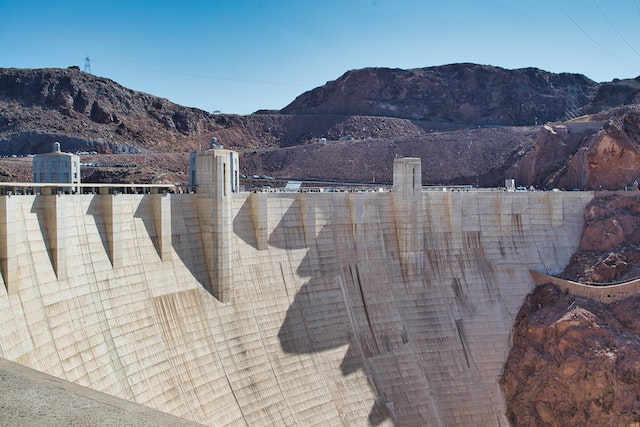
Why was the Hoover Dam so difficult to build? Because the river was very strong and the dam was so big, the concrete would take 125 years to set.
A new source of irrigation and drinking water was needed by the end of the 19th century as more and more people settled the south west of the country. The Colorado River seemed like a good option. Cities were slowly being electrified as well, and it seemed like a good opportunity to make a hydroelectric dam. The location was chosen in the early 1920s, but then it took a long time to pass the legislation. Herbert Hoover, the Secretary of Commerce at the time, helped, but he didn’t have a lot to do with it at the time. The Hoover Dam was finished in 1935, but it wasn’t called the Hoover Dam until 1947. Hoover became president in 1929 and he was president during the first 60% of the construction. Roosevelt took a lot of the credit for the dam as part of his efforts to get America out of the Great Depression. The dam was called the Boulder Dam in the early days. The Democrats and the Republicans fought over the name, with the Democrats calling it the Boulder Dam and the Republicans calling it the Hoover Dam. The Republicans won the battle in 1947 and it has been known as the Hoover Dam ever since.
So, what made it so difficult to build? The first major problems were the legal ones. The states upriver and down river were worried about losing their water supply. People also thought a hydroelectric dam of that size would produce far more electricity than the surrounding area could absorb. Some people thought the weight of the dam would cause earthquakes and if it failed it would devastate the area.
The first physical challenge was diverting the river. This was done by digging four tunnels through the canyon walls. Each tunnel was 17 m wide, but then they were lined with 1 meter of concrete to protect them. When they were ready, the main river was blocked and the water was diverted through these tunnels and back into the river further downstream. When the dam was completely finished, the tunnels were blocked with concrete plugs.
The next, and most significant problem was the huge amount of concrete the dam required. The Bureau of Reclamation worked out that if the concrete was just poured into the frame of the dam, it would take 125 years to cure and the dam wouldn’t be strong enough to use for a long time. It would dry unevenly and it could crack under the force of the river. The desert that the dam was built in is very hot and the surface of the dam would cure much faster than other parts of it. That could cause parts of the dam to shrink and then it would fail. They couldn’t have that, so they had to come up with another way to do it.
When concrete cures, it produces a lot of heat because the molecules in the cement react with the water, producing calcium silicate hydrate and heat. If you are just concreting your patio, the heat can escape into the air and you don’t have a problem, but if you are making an enormous dam out of concrete, the heat cannot escape, and the dam cannot cure properly. The engineers working on the Hoover Dam decided to make the dam in pieces to get around this problem.
A concrete plant was built at the site of the dam, and it produced enormous buckets of concrete. The dam was divided up into sections of different sizes: some 7 m by 7 m, and some larger ones of 20 m by 20 m. The concrete was cooled as much as possible before pouring, and then it was poured into the blocks. Steel pipes were pushed into the setting concrete and water from the Colorado River was run through the pipes to take away as much heat from the concrete block as possible. They also used water cooled with blocks of ice produced by the ammonia refrigeration plant on site. The cold water helped draw the heat out of the blocks and allowed them to cure more quickly and more evenly. Once they were cured enough, the next block would be added. In this way, the whole dam could be built in 4 years, and it is phenomenally strong. It is still hardening and getting stronger as you read this. It is designed to last for 2,000 years, but it will probably last for at least 10,000 years. And this is what I learned today.
Photo by Carlin Harris: https://www.pexels.com/photo/the-hoover-dam-8527329/
Sources
https://www.linkedin.com/pulse/why-concrete-temperature-important-especially-during-extremes-canute/
https://www.usbr.gov/lc/phoenix/AZ100/1930/hoover_dam.html
https://en.wikipedia.org/wiki/Hoover_Dam
https://time.com/4045046/hoover-dam-name-history/
